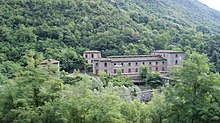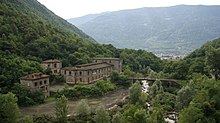Piattamala
Piattamala refers to a parcel of land and a castle (or tower) of the same name, which existed here from around the 12th century to 1513 and from 1620 to 1639 and secured the route to and from the Poschiavo and the Bernina Pass .
Today the Hotel Castello stands here (about 495 m slm ). Piattamala belongs to the Italian municipality of Tirano in Valtellina , Province of Sondrio , Lombardy .
Location, geographic origin and military importance
Piattamala is located about 400 meters as the crow flies south of today's Swiss border (800 meters from the border town of Campocologno ), and about 1100 meters from the Basilica Madonna di Tirano and 2.3 kilometers from the old town of Tirano. Piattamala and the Hotel Castello are located on the south-west running SS 38 dir (Italy), which continues in Switzerland as Hauptstrasse 29 ( Canton of Graubünden ). The place can be seen very well from the Bernina Railway . Below Piattamala, the Poschiavino flows towards Tirano. Piattamala is a heaped alluvial cone of the Poschiavino, on which the former castle and later the hotel and its outbuildings were built.
The Poschiavino near Piattamala forms a natural, strategically favorable bottleneck for a military fortification to control traffic between Italy and Switzerland through the Poschiavo. On a fresco from the 16th century in the basilica Madonna di Tirano - at the place where the basilica stands today, the feast of St. Michael the Mother of God appeared at dawn on September 29, 1504 - there is a schematic representation in the background from Piattamala, the castle and the strategic location. On the left of the fresco the church and tourist accommodation (Xenodochio) Santa Perpetua is shown.
history
Similar bronze objects were found in Piattamala as well as on Alp Grüm , from which it is concluded that the valley represented a transit route across the Alps from the earliest times ; a permanent settlement at this time could not be proven.
In the 12th century the tower of the Piattamala Castle was built by the Capitanei of Stazzona . The Capitanei of Stazzona only existed for a short time; she was subordinate to the formerly free municipality of Tirano.
Milan defeated Como in 1335 , and the Poschiavo came under the rule of the Visconti in 1350 . In 1406 the valley inhabitants revolted against the award of the Poschiavo fief to Giovanni Malacrida von Musso . In 1408 they therefore placed themselves under the jurisdiction of the Bishop of Chur and joined the Church of God . In 1410, the Graubünden municipalities of Poschiavo and Brusio in the Upper Engadin pledged to several municipalities in the Valtelline region to maintain the road to Piattamala at the exit of the Poschiavo . Between 1429 and 1521 the Swiss border between Brusio and the Valtellina was moved south via Campocologno, making Campocologno part of Brusio. Campocologno had previously for Commune spell of Tirano belongs. In mid-February 1487, around 600 people from Graubünden tried again to penetrate the Valtellina from the Splügen Pass , Bergell and Piattamala; but they were repulsed. In 1487 the natural dam near Piattamala was heavily fortified and expanded by Ludovico il Moro after he had to cede the Poschiavo back to the Grisons . The architect Giovanni Antonio Amadeo took over this task in 1488 because the duke feared the new aggressive policy of the Swiss (see also: City fortifications of Tirano ). When Valtellina was conquered by the Bündner in 1512, a French occupation remained in Piattamala for the entire summer . The conquest of the Valtellina by the Bündner in 1512 made the Poschiavo an increasingly important intermediate space and transit point for trade over the centuries. In 1513 the fortress of Piattamala was razed by the Grisons . In 1518 the border of the court was moved south to the tower of Piattamala near Campocologno in order to put an end to the centuries-old border disputes with the municipality of Tirano (see also: San Rocco (Tirano) ). During the Thirty Years War , 1618 to 1648, the fortress in Piattamala was restored and reinforced between 1620 and 1639.
On the night of July 18-19, 1620, a Catholic uprising began in Tirano under the leadership of Jakob Robustelli, Marc Anton Venosta von Grosio, Vincent Venosta von Mazzo and Francis Venosta von Tirano. The city gates were occupied by conspirators in the early hours of the morning and all people were called out into the street by ringing bells. Subsequently, all people of the Reformed faith that could be caught were killed. The Bündner Landrichter, the podiums of Tirano and Teglio and another 60 people were killed (see: Veltliner Murder ). In the Grisons valley of Poschiavo, the Reformed learned about the events in Tirano on the same day and tried to rush to the aid of their co-religionists. However, the conspirators had already blocked the way at Piattamala.
Web links
- Guido Scaramellini: Le fortificazioni in Valtellina, Valchiavenna e Grigioni (Italian)
Individual evidence
- ↑ a b c d Arno Lanfranchi: Puschlav. In: Historical Lexicon of Switzerland .
- ↑ a b Martin Bundi: Tirano. In: Historical Lexicon of Switzerland .
- ↑ a b c Guido Scaramellini: Chiavenna. In: Historical Lexicon of Switzerland .
- ^ Martin Bundi: Bernina Pass. In: Historical Lexicon of Switzerland .
- ^ A b Adolf Collenberg: Campocologno. In: Historical Lexicon of Switzerland .
- ^ Poschiavo - Valtellina excursion report from the Swiss Castle Association.
Coordinates: 46 ° 13 ′ 37.2 ″ N , 10 ° 8 ′ 52.2 ″ E

